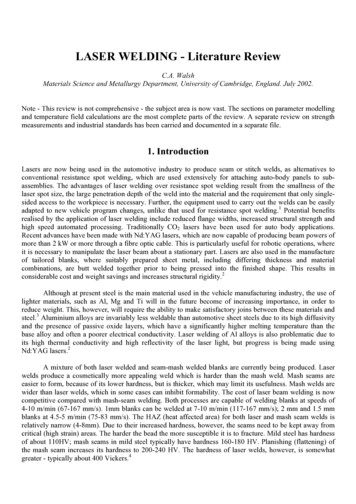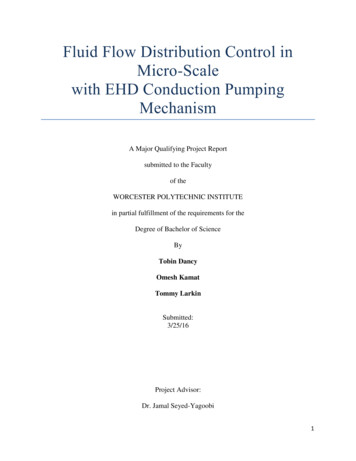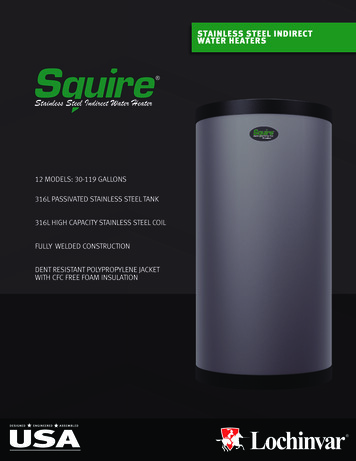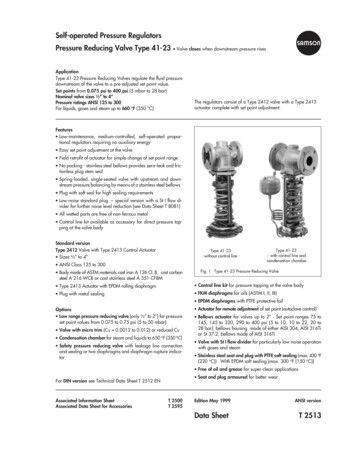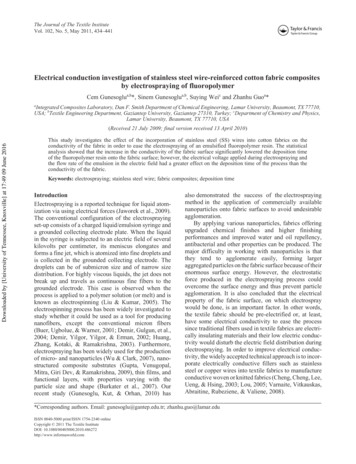
Transcription
The Journal of The Textile InstituteVol. 102, No. 5, May 2011, 434–441Electrical conduction investigation of stainless steel wire-reinforced cotton fabric compositesby electrospraying of fluoropolymerCem Gunesoglua,b*, Sinem Gunesoglua,b, Suying Weic and Zhanhu Guoa*aIntegrated Composites Laboratory, Dan F. Smith Department of Chemical Engineering, Lamar University, Beaumont, TX 77710,USA; bTextile Engineering Department, Gaziantep University, Gaziantep 27310, Turkey; cDepartment of Chemistry and Physics,Lamar University, Beaumont, TX 77710, USA(Received 21 July 2009; final version received 13 April 2010 )Taylor and FrancisThis study investigates the effect of the incorporation of stainless steel (SS) wires into cotton fabrics on theconductivity of the fabric in order to ease the electrospraying of an emulsified fluoropolymer resin. The statisticalanalysis showed that the increase in the conductivity of the fabric surface significantly lowered the deposition timeof the fluoropolymer resin onto the fabric surface; however, the electrical voltage applied during electrospraying andthe flow rate of the emulsion in the electric field had a greater effect on the deposition time of the process than theconductivity of the fabric.Downloaded by [University of Tennessee, Knoxville] at 17:49 09 June 201610.1080/00405000.2010.486272Keywords: electrospraying; stainless steel wire; fabric composites; deposition timeIntroductionElectrospraying is a reported technique for liquid atomization via using electrical forces (Jaworek et al., 2009).The conventional configuration of the electrosprayingset-up consists of a charged liquid/emulsion syringe anda grounded collecting electrode plate. When the liquidin the syringe is subjected to an electric field of severalkilovolts per centimeter, its meniscus elongates andforms a fine jet, which is atomized into fine droplets andis collected in the grounded collecting electrode. Thedroplets can be of submicron size and of narrow sizedistribution. For highly viscous liquids, the jet does notbreak up and travels as continuous fine fibers to thegrounded electrode. This case is observed when theprocess is applied to a polymer solution (or melt) and isknown as electrospinning (Liu & Kumar, 2005). Theelectrospinning process has been widely investigated tostudy whether it could be used as a tool for producingnanofibers, except the conventional micron fibers(Buer, Ugbolue, & Warner, 2001; Demir, Gulgun, et al.,2004; Demir, Yilgor, Yilgor, & Erman, 2002; Huang,Zhang, Kotaki, & Ramakrishna, 2003). Furthermore,electrospraying has been widely used for the productionof micro- and nanoparticles (Wu & Clark, 2007), nanostructured composite substrates (Gupta, Venugopal,Mitra, Giri Dev, & Ramakrishna, 2009), thin films, andfunctional layers, with properties varying with theparticle size and shape (Burkater et al., 2007). Ourrecent study (Gunesoglu, Kut, & Orhan, 2010) hasalso demonstrated the success of the electrosprayingmethod in the application of commercially availablenanoparticles onto fabric surfaces to avoid undesirableagglomeration.By applying various nanoparticles, fabrics offeringupgraded chemical finishes and higher finishingperformances and improved water and oil repellency,antibacterial and other properties can be produced. Themajor difficulty in working with nanoparticles is thatthey tend to agglomerate easily, forming largeraggregated particles on the fabric surface because of theirenormous surface energy. However, the electrostaticforce produced in the electrospraying process couldovercome the surface energy and thus prevent particleagglomeration. It is also concluded that the electricalproperty of the fabric surface, on which electrospraywould be done, is an important factor. In other words,the textile fabric should be pre-electrified or, at least,have some electrical conductivity to ease the processsince traditional fibers used in textile fabrics are electrically insulating materials and their low electric conductivity would disturb the electric field distribution duringelectrospraying. In order to improve electrical conductivity, the widely accepted technical approach is to incorporate electrically conductive fillers such as stainlesssteel or copper wires into textile fabrics to manufactureconductive woven or knitted fabrics (Cheng, Cheng, Lee,Ueng, & Hsing, 2003; Lou, 2005; Varnaite, Vitkauskas,Abraitine, Rubeziene, & Valiene, 2008).*Corresponding authors. Email: gunesoglu@gantep.edu.tr; zhanhu.guo@lamar.eduISSN 0040-5000 print/ISSN 1754-2340 onlineCopyright 2011 The Textile InstituteDOI: d.com
The Journal of The Textile InstituteDownloaded by [University of Tennessee, Knoxville] at 17:49 09 June 2016In this study, the effect of the incorporation of stainless steel (SS) wires into cotton fabrics on the conductivity of fluoropolymer resin-treated fabric compositeswas investigated using the electrospraying process. SSwires of three different diameters were twisted with a100% cotton yarn individually. The resulting hybridyarns were used to produce knitted fabric samples as acomposite structure having increased conductivity. Thecommercially available fluoropolymer resin finishingchemical, considered as nanoparticle according to itsparticle size, was electrosprayed onto the samples. Thefacile process was evaluated by measuring the deposition time of certain number of droplets of the resin.ExperimentalWe took 316L austenitic SS metallic wires with adiameter of 18 µm, 35 µm, and 50 µm, respectively,which were twisted with a Ne 50/1 count 100% cottoncombed yarn using the hollow spindle covering technique. The longitudinal views of the hybrid yarns aregiven in Figure 1. All the fabric samples were preparedfrom the obtained hybrid yarns on a laboratory-typesample knitting machine (SDL Atlas Quickknit, 3.5Plus, 4-gauge) under the same settings. A 100% cottonsample was also knitted with the abovementionedcombed yarn as a control specimen. The general overview of the RL knitted samples is given in Table 1.Resistivity measurements were performed on thesamples by a multimeter Keithley model 2400 (Cleveland, OH). The four-probe technique is regarded as theFigure 1.Longitudinal views of hybrid yarns containing (a) 18- µm SS (b) 35- µm SS, and (c) 50- µm SS, at the magnification of 25 .Table 1.most convenient tool to measure the electrical resistivityfor a large number of reasons (Gomes, Soares, & Pinto,2008). An early approach, introduced in 1954 by Valdes(Valdes, 1954), consists of placing four probes along astraight line, separated from each other by a distance s.The electrical contact is made along a straight line on thesurface of the material, which possesses a thickness w,and the electrical current flows through the outer pair ofprobes, while the floating electrical potential is measuredbetween the inner pair of probes (see Figure 2).Bulk resistivity (ρv) is then calculated in accordancewith the following equation:Figure 2.Representation of the four-probe technique.ρv V 2π 1 111 I C. F. ssssss3 12122(1)where V is the difference in the potential (in volts)between the inner pair of probes, I is the electricalcurrent that flows through the outer pair of probes, snrepresents the distances between two adjacent probes,and C.F. is a correction factor that depends on w and snand is determined by the following equation: s 11C. F. 1 4 22w n 1 s 2s 22 4n 4n w w (2 ) Constructional properties of the fabrics.Fabric codeYarn typeCC18C35C50Ne 50/1 count 100% cottonNe 50/1 count 100% cotton 18-µm SSNe 50/1 count 100% cotton 35-µm SSNe 50/1 count 100% cotton 50-µm SSa435Wa/cmCa/cmha (cm)Weight 120.3210.1W, wales; C, courses; h, thickness.Figure 1.Longitudinal views of hybrid yarns containing (a) 18-µm SS (b) 35-µm SS, and (c) 50-µm SS, at the magnification of 25 .
436Downloaded by [University of Tennessee, Knoxville] at 17:49 09 June 2016Figure 2.C. Gunesoglu et al.Representation of the four-probe technique.where s is the average distance among the probes, w isthe thickness of the test sample, and n is the countingnumber.To perform a four-probe measurement, four 100%carbon strips (width 0.5 cm) separated by a distance of0.3 cm, were placed on the samples and connected tothe probes with copper wires. Then, the difference inthe potential between the inner pair of probes and theelectrical current flowing through the set-upwere recorded by the multimeter. The conductivity (σ,in S/m) of the samples was determined in accordancewith the following equation:σ 1ρν( 3)where ρv is the bulk resistivity (in Ω cm).The difference in the potential between the inner pairof probes and the electrical current data used to calculatebulk resistivity and conductivity of the samples were anaverage of 50 measurements for each sample.The commercially available fluoropolymer resin (apolyoxyalkylene-containing perfluoroalkyl compound,which has dipropylene glycol methacrylate 8–10% byweight and a density of 1.02 g/cm3) was supplied byRudolf-Duraner, Bursa. The particle size and multimodal size distribution measurements of the chemical wereperformed with a Brookhaven Instruments 90 Plus(Holtsville, NY) using the dynamic light scattering technique and the effective diameter (Deff) was measured as104.4 nm (Gunesoglu, Kut, & Orhan, 2007).The electrospray applications were carried out witha previously established set-up (Zhang et al., 2009), inwhich 5 mL of the emulsion (comprising 40 g/Lfluoropolymer resin in distilled water) was poured intothe charged syringe, which was connected to a highvoltage power supply, and sprayed onto the fabricsample placed on the grounded collecting electrode.The grounded electrode was a flat aluminum foil thatenabled large contact between the stainless steel wire ofthe samples and the electrode itself. The basic configuration of the set-up is given in Figure 3.Figure 3.Figure 3.Electrospraying set-up.Electrospraying set-up.
Downloaded by [University of Tennessee, Knoxville] at 17:49 09 June 2016The Journal of The Textile Institute437The distance between the syringe and the collectingelectrode was maintained at 10 cm in all applications.Furthermore, the electrical voltage and the flow rate aswell as the fabric type were taken as process factors tobe investigated in the study. The applied electrical voltage was controlled at 8, 9, and 10 kV. The flow ratehad five treatment levels, 10, 15, 20, 25, and 30 µL/min. At each combination of factor levels, dropletformation was easy to monitor and the time for thedeposition of 10 droplets onto the samples wasmeasured by a simple chronometer: the less the time,the more facile the process is. The average of at leastfour measurements of the deposition time was taken asthe time data.The contribution of each factor was assessed using acompletely randomized two-way analysis of variance(ANOVA). The results were evaluated at 5% significance level. The regression equations between deposition time, electrical voltage, flow rate, and conductivityof the samples were derived by using Minitab software(Minitab Inc., PA).Treated and gold-coated samples were observed byHitachi 3400 N scanning electron microscope (SEM) at5, 10, and 15 kV of accelerating voltages.Results and discussionFigure 4 shows the composite structure of the SS wireincorporated samples. The metallic wire is distinguished from cotton fibers by its continuous structureand white appearance. SS wires also gained a loopstructure within fabric construction.Figure 5 exhibits the deposited fluoropolymer nanoparticles on the fiber and metal wire surface withoutlarge agglomerates as proposed.The measured values of bulk resistivity and conductivity of the samples are presented in Table 2. Theresults showed that SS wire incorporation into cottonfabrics reduced bulk resistivity dramatically andaffected conductivity significantly; however, allsamples incorporated with SS wires gave similar valuesof conductivity, although C35 and C50 had clearlyhigher proportions of SS wire. Thus, it is concluded thatmetallic wire incorporation mainly affects the thicknessof the fabric (see Table 1), which is an important factorin increasing bulk resistivity.Figure 6 shows the deposition time of 10 dropletsonto the samples. The results reveal that there is acertain decrease in the deposition time as the flowrate and electrical voltage values increase for eachsample.The ANOVA was performed to demonstrate theimportance and contribution of each variable (electricalvoltage applied, flow rate and fabric type) using allexperimental data. The results were evaluated based onFigure 4.The composite structure of SS wire-incorporated samples: (a) C50 (b) C53, and (c) C18.Figure 5.SEM images of (a) single cotton fiber from sample C, (b) SS wire and cotton fibers from sample C18 and (c) SS wire and cotton fibers from sample C35, and (d) cotton fiber bundle from sample C50 showing fluoropolymer deposition without agglomeration.Figure 6.Deposition time of 10 droplets onto the samples: (a) C (b) C18 (c) C35, and (d) C50.Figure 4. Composite structure of SS wire-incorporatedsamples: (a) C50 (b) C53, and (c) C18.the F-ratio and the probability of the F-ratio. Thehigher the F-ratio and the lower the probability of the Fratio, the stronger the contribution of the variable andthe more significant the variable is. The result ofANOVA is given in Table 3. The result showed that theapplied electrical voltage and flow rate had more
Downloaded by [University of Tennessee, Knoxville] at 17:49 09 June 2016438C. Gunesoglu et al.Figure 5. SEM images of (a) single cotton fiber from Sample C, (b) SS wire and cotton fibers from Sample C18 and (c) SS wireand cotton fibers from Sample C35, and (d) cotton fiber bundle from Sample C50 showing fluoropolymer deposition withoutagglomeration.Table 2.Bulk resistivity and conductivity of the samples.Fabric codeρv (Ω cm)σ (S/cm)CC18C35C504.38 10657.2637.0935.244.11 10 80.0180.0270.028significant impact on the deposition time than thesample conductivity.When all data were grouped in line plots, significant relations between deposition time and appliedvoltage and deposition time and flow rate wereobserved. However, a weaker relation was observedbetween deposition time and sample conductivity(Figure 7).To define the exact classification of the variables,the Student–Newman–Keuls (SNK) range test was usedto designate which variable differs significantly fromothers (Table 4). The treatment levels were ranked withFigure 7.Fitted line plots between electrospraying variables (a) electrical voltage (b) flow rate, and (c) sample conductivity, and deposition time.the mean values of deposition time from the highest tothe lowest. Any levels marked by the same letter (a, b,c, d, and e) shows that they were not significantly different. The contribution of fabric type was found to bethe only significant parameter depending on whetherthe fabric contains the SS wires or not. In otherwords, the incorporation of SS wires decreased thedeposition time. The higher the conductivity of thefabric type, the lower the deposition time of the electrospraying of the solution is. The samples here show anincreasing order of conductivity for the fabric types C C18 C35 C50. The incorporation of the wires has asignificant effect on the electrospraying process ratherthan the diameter of the SS wires, as indicated inTable 4. Furthermore, each treatment level of the flowrate and the process voltage was significantly differentfrom others.The combined contribution of the operationalparameters (applied electrical voltage, flow rate and theconductivity of fabric substrate) to the electrosprayingdeposition time of the resin emulsion was fitted by
The Journal of The Textile InstituteTable 3.ANOVA table for deposition time.SourceF-ratioProbability(F-ratio)Main levelFabric typeFlow rateApplied electrical voltage .0000.00040.080.0006.990.000InteractionFabric type flow rateFabric type applied electricalvoltageFlow rate applied electricalvoltageFabric type applied electricalvoltage flow rateDownloaded by [University of Tennessee, Knoxville] at 17:49 09 June 2016439t 60.2 4.38 V 0.51 U 1.4 σ( 4)where t is the deposition time (seconds), V is the appliedvoltage (kV), U is the flow rate (µL/min), and σ is theelectrical conductivity of the samples (S/cm).ConclusionThis study investigates the conductivity of fabricsincorporated with SS wires onto which a nanoparticlechemical was electrosprayed. The incorporation ofconductive SS wires within the fabric structureincreased the conductivity of the fabrics. Compositefabric samples with SS wires of different diameterswere prepared, exhibiting different resistivity values.The commercially available fluoropolymer nanoparticleemulsion was electrosprayed onto the fabrics under aconventional set-up. The facile process was evaluatedby measuring the deposition time as a function of boththe applied electrical voltage and the flow rate. Thestatistical analysis showed two important results: Figure 6. Deposition time of 10 droplets onto the samples:(a) C, (b) C18, (c) C35, and (d) C50.using the Minitab software. The relation was determined after considering all the variables according tothe best-subsets regression method and is given in thefollowing equation:The conductivity of a fabric surface could beincreased by the incorporation of traditional SSwires, which in turn would lower the depositiontime of electrospraying. However, this effect wasfound to be related only to the presence of wiresand not to the diameter of the SS wires and totheir proportions within fabrics. The macrostructure of SS wires (Figure 4) shows that the incorporation of SS wires into cotton fabrics mainlyaffects the fabric thickness and thus yields higherbulk resistivity. Therefore, it is concluded thatcomparable conductive fabric surfaces will needmicro- and nano-conductive fillers for effectiveelectrospraying. This study motivates the research
C. Gunesoglu et al.Downloaded by [University of Tennessee, Knoxville] at 17:49 09 June 2016440Figure 7. Fitted line plots between electrospraying variables (a) electrical voltage (b) flow rate, and (c) sample conductivity, anddeposition time. in this area to move forward with conductivenanofillers, which is still going on.The flow rate and electrical voltage values of anelectrospraying process are more determinativefactors when compared with that of SS wire-incorporated cotton fabric composite conductivity. The electrospraying process is justified to bean alternative approach to coat different kinds offabric surfaces of different conductivities withnanoparticles.
The Journal of The Textile InstituteDownloaded by [University of Tennessee, Knoxville] at 17:49 09 June 2016Table 4.SNK ranking at 5% significance level.RankFabric codeNon-significant range1234Rank12345Rank123CC18C35C50Flow rate (µL/min)1015202530Applied voltage (kV)8910abbbNon-significant rangeabcdeNon-significant rangeabcAcknowledgementsThis work was supported by the Scientific Research ProjectGoverning (BABYP) of Gaziantep University under ContractNo. MF.09.02 and TUBITAK BIDEB 2219 Grant.ReferencesBuer, A., Ugbolue, S.C., & Warner, S.B. (2001). Electrospinning and properties of some nanofibers. TextileResearch Journal, 71, 323–328.Burkater, E., Saul, C.K., Thomazi, F., Cruz, N.C., Roman,L.S., & Schreiner, W.H. (2007). Superhydrophobicelectrosprayed PTFE. Surface & Coating Technology,202, 194–198.Cheng, K.B., Cheng, T.W., Lee, K.C., Ueng, T.H., & Hsing,W.H. (2003). Effects of yarn constitutions and fabricspecifications on electrical properties of hybrid wovenfabrics. Composites: Part A, 34, 971–978.Demir, M.M., Gulgun, M.A., Menceloglu, Y.Z., Erman, B.,Abramchuk, S.S., Makhaeva, E.E., & Sulman, M.G.(2004). Palladium nanoparticles by electrospinning frompoly(acrylonitrile–co–acrylic acid)–PdCl2 solutions. Relations between preparation conditions, particle size, andcatalytic activity. Macromolecules, 37, 1787–1792.441Demir, M.M., Yilgor, I., Yilgor, E., & Erman, B. (2002).Electrospinning of polyurethane fibers. Polymer, 43,3303–3309.Gomes, F., Soares, B.G., & Pinto, J.C. (2008). Electricalsurface resistivity of conductive polymers: A nonGaussian approach for determination of confidenceintervals. European Polymer Journal, 44, 3908–3914.Gunesoglu C., Kut, D., & Orhan, M. (2007). The effect ofparticle size of finishing chemicals on color assessmentof treated cotton fabrics. Journal of Applied PolymerScience, 104, 2587–2594.Gunesoglu, C., Kut, D., & Orhan, M. (2010). Performingthe electrospraying process for application of textilenano finishing particles. Textile Research Journal,80(2), 106–115.Gupta, D., Venugopal, J., Mitra, S., Giri Dev, V.R., &Ramakrishna, S. (2009). Nanostructured biocompositesubstrates by electrospinning and electrospraying forthe mineralization of osteoblasts. Biomaterials, 30,2085–2094.Huang, Z.-M., Zhang, Y.Z., Kotaki, M., & Ramakrishna, S.(2003). A review on polymer nanofibers by electrospinning and their applications in nanocomposites. Composites Science and Technology, 63, 2223–2253.Jaworek, A., Krupa, A., Lackowski, M., Sobczyk, A.T.,Czech, T., Ramakrishna, S., Sundarrajan, S., & Pliszka,D. (2009). Nanocomposite fabric formation by electrospinning and electrospraying technologies. Journal ofElectrostatistics, 67, 435–438.Liu, J., & Kumar. S. (2005). Microscopic polymer cups byelectrospinning. Polymer, 46, 3211–3214.Lou C.W. (2005). Process of complex core spun yarncontaining a metal wire. Textile Research Journal, 75,466–473.Valdes, L.B. (1954). Resistivity measurements on germanium for transistors. Proceedings of the Institute ofRadio Engineers, 42(2), 420–427.Varnaite, S., Vitkauskas, A., Abraitine, A., Rubeziene, V., &Valiene, V. (2008). The features of electric charge decayin the polyester fabric containing metal fibres. MaterialsScience, 14(2), 157–161.Wu, Y., & Clark, R.L. (2007). Controllable porous polymerparticles generated by electrospraying. Journal ofColloid and Interface Science, 310, 529–535.Zhang, D., Karki, A.B., Rutman, D., Young, D.P., Wang, A.,Cocke, D., et al. (2009). Electrospun polyacrylonitrilenanocomposite fibers reinforced with Fe3O4 nanoparticles: Fabrication and property analysis. Polymer, 50,4189–4198.
Electrical conduction investigation of stainless steel wire-reinforced cotton fabric composites by electrospraying of fluoropolymer Cem Gunesoglu a,b *, Sinem Gunesoglu a,b, Suying Wei c and Zhanhu Guo a * a Integrated Composites Laboratory, Dan F. Smith Department of Chemical Engineering, Lamar University, Beaumont, TX 77710, USA; b


